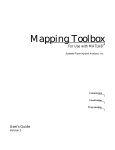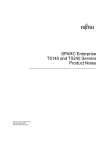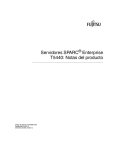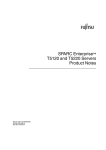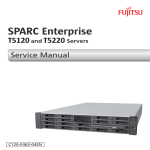Download Sun SPARC Enterprise T5120 and T5220 Servers Product Notes
Transcript
Sun SPARC Enterprise® T5120 and
T5220 Servers
Product Notes
Part No. 820-2176-22
March 2010, Revision A
Copyright © 2009, 2010, Sun Microsystems, Inc., 4150 Network Circle, Santa Clara, California 95054, U.S.A. All rights reserved.
Sun Microsystems, Inc. has intellectual property rights relating to technology that is described in this document. In particular, and without
limitation, these intellectual property rights may include one or more of the U.S. patents listed at http://www.sun.com/patents and one or
more additional patents or pending patent applications in the U.S. and in other countries.
This document and the product to which it pertains are distributed under licenses restricting their use, copying, distribution, and
decompilation. No part of the product or of this document may be reproduced in any form by any means without prior written authorization of
Sun and its licensors, if any.
Third-party software, including font technology, is copyrighted and licensed from Sun suppliers.
Parts of the product may be derived from Berkeley BSD systems, licensed from the University of California. UNIX is a registered trademark in
the U.S. and in other countries, exclusively licensed through X/Open Company, Ltd.
Sun, Sun Microsystems, the Sun logo, Java, AnswerBook2, docs.sun.com, Sun StorageTek, and Solaris are trademarks or registered trademarks
of Sun Microsystems, Inc., or its subsidiaries, in the U.S. and in other countries.
All SPARC trademarks are used under license and are trademarks or registered trademarks of SPARC International, Inc. in the U.S. and in other
countries. Products bearing SPARC trademarks are based upon an architecture developed by Sun Microsystems, Inc.]
The OPEN LOOK and Sun™ Graphical User Interface was developed by Sun Microsystems, Inc. for its users and licensees. Sun acknowledges
the pioneering efforts of Xerox in researching and developing the concept of visual or graphical user interfaces for the computer industry. Sun
holds a non-exclusive license from Xerox to the Xerox Graphical User Interface, which license also covers Sun’s licensees who implement OPEN
LOOK GUIs and otherwise comply with Sun’s written license agreements.
U.S. Government Rights—Commercial use. Government users are subject to the Sun Microsystems, Inc. standard license agreement and
applicable provisions of the FAR and its supplements.
DOCUMENTATION IS PROVIDED "AS IS" AND ALL EXPRESS OR IMPLIED CONDITIONS, REPRESENTATIONS AND WARRANTIES,
INCLUDING ANY IMPLIED WARRANTY OF MERCHANTABILITY, FITNESS FOR A PARTICULAR PURPOSE OR NON-INFRINGEMENT,
ARE DISCLAIMED, EXCEPT TO THE EXTENT THAT SUCH DISCLAIMERS ARE HELD TO BE LEGALLY INVALID.
Copyright © 2009, 2010, Sun Microsystems, Inc., 4150 Network Circle, Santa Clara, Californie 95054, États-Unis. Tous droits réservés.
Sun Microsystems, Inc. possède les droits de propriété intellectuels relatifs à la technologie décrite dans ce document. En particulier, et sans
limitation, ces droits de propriété intellectuels peuvent inclure un ou plusieurs des brevets américains listés sur le site
http://www.sun.com/patents ,un ou les plusieurs brevets supplémentaires ainsi que les demandes de brevet en attente aux les États-Unis
et dans d’autres pays.
Ce document et le produit auquel il se rapporte sont protégés par un copyright et distribués sous licences, celles-ci en restreignent l’utilisation,
la copie, la distribution, et la décompilation. Aucune partie de ce produit ou document ne peut être reproduite sous aucune forme, par quelque
moyen que ce soit, sans l’autorisation préalable et écrite de Sun et de ses bailleurs de licence, s’il y en a.
Tout logiciel tiers, sa technologie relative aux polices de caractères, comprise, est protégé par un copyright et licencié par des fournisseurs de
Sun.
Des parties de ce produit peuvent dériver des systèmes Berkeley BSD licenciés par l’Université de Californie. UNIX est une marque déposée
aux États-Unis et dans d’autres pays, licenciée exclusivement par X/Open Company, Ltd.
Sun, Sun Microsystems, le logo Sun, Java, AnswerBook2, docs.sun.com, Sun StorageTek, et Solaris sont des marques de fabrique ou des
marques déposées de Sun Microsystems, Inc., ou ses filiales, aux États-Unis et dans d’autres pays.
Toutes les marques SPARC sont utilisées sous licence et sont des marques de fabrique ou des marques déposées de SPARC International, Inc.
aux États-Unis et dans d’autres pays. Les produits portant les marques SPARC sont basés sur une architecture développée par Sun
Microsystems, Inc.
L’interface utilisateur graphique OPEN LOOK et Sun™ a été développée par Sun Microsystems, Inc. pour ses utilisateurs et licenciés. Sun
reconnaît les efforts de pionniers de Xerox dans la recherche et le développement du concept des interfaces utilisateur visuelles ou graphiques
pour l’industrie informatique. Sun détient une license non exclusive de Xerox sur l’interface utilisateur graphique Xerox, cette licence couvrant
également les licenciés de Sun implémentant les interfaces utilisateur graphiques OPEN LOOK et se conforment en outre aux licences écrites de
Sun.
LA DOCUMENTATION EST FOURNIE "EN L’ÉTAT" ET TOUTES AUTRES CONDITIONS, DÉCLARATIONS ET GARANTIES EXPRESSES
OU TACITES SONT FORMELLEMENT EXCLUES DANS LA LIMITE DE LA LOI APPLICABLE, Y COMPRIS NOTAMMENT TOUTE
GARANTIE IMPLICITE RELATIVE À LA QUALITÉ MARCHANDE, À L’APTITUDE À UNE UTILISATION PARTICULIÈRE OU À
L’ABSENCE DE CONTREFAÇON.
Please
Recycle
Contents
1.
Product Notes for the Sun SPARC Enterprise T5120 and T5220 Servers
General Information
1
Major New Features
Technical Support
1
2
Downloading Documentation
2
Supported Versions of Solaris and Sun System Firmware
2
Solaris OS and Firmware Requirements for Certain Features
Preinstalled Software
Patch Information
1
4
5
5
Patches Required for the Solaris 10 5/09 OS
6
Patches Required for the Solaris 10 10/08 OS
Patches Required for the Solaris 10 8/07 OS
Patches for Option Cards
6
6
Rules for PCIe Slot Use by Certain HBA Cards
Known Product Issues
6
7
8
Hardware and Mechanical Issues
9
False Intermittent SATA Errors Seen on Sun SPARC Enterprise T5120,
T5220, T5140, and T5240 Systems (CR 6880299) 10
Misalignment of Backplane to HDD Cage in Some 8- and 16-Disk
Systems 10
iii
Hard Drives Can Be Difficult to Remove From Right-Side Drive Bays
Ethernet Interface Related Issues
Solaris OS Issues
11
12
13
Boot Drive May Report “drive type unknown” for Solaris format Command
(CR 6886514) 13
Firmware, ILOM, POST, and SP Issues
20
SSDs Require Firmware Updates To Be Used In Sun StorageTek SAS RAID
Configurations 20
Boot From SATA DVD Limitation
21
Communication Channel Between the Primary Domain and the Service
Processor (SP) Might Hang (CR 6583567) 21
Diagnostic Routine That Runs at Startup (IBIST) Might Accidentally
Disconnect the MCU (CR 6618773) 22
Product Documentation Errata
22
Incorrect SAS RAID HBA Data Cable Routing Information for Systems With
8- or 16-Disk Capable Backplanes (CR 6776592) 23
Corrections for the Service Manual
23
Corrections for the HBA Installation Manual
25
Fan Configuration Diagram is Incorrect for Systems With 16-Disk
Backplanes 26
Verify Proper Seating of Preinstalled PCIe/XAUI Cards
26
Incorrect Values for the 1.6 GHz SpecJBB Test in the Sun SPARC Enterprise
T5120 and T5220 Site Planning Guide 27
Incorrect Idle Input Power Values Specified in the Sun SPARC Enterprise T5120
and T5220 Site Planning Guide 28
iv
Sun SPARC Enterprise T5120 and T5220 Servers Product Notes • March 2010
CHAPTER
Product Notes for the Sun SPARC
Enterprise T5120 and T5220 Servers
These product notes contain important and late-breaking information about the Sun
SPARC Enterprise® T5120 and T5220 servers.
This information is organized into the following sections:
■
“General Information” on page 1
■
“Supported Versions of Solaris and Sun System Firmware” on page 2
■
“Solaris OS and Firmware Requirements for Certain Features” on page 4
■
“Preinstalled Software” on page 5
■
“Patch Information” on page 5
■
“Rules for PCIe Slot Use by Certain HBA Cards” on page 7
■
“Known Product Issues” on page 8
■
“Product Documentation Errata” on page 22
General Information
This section contains information of a general interest.
Major New Features
The following new features have been added to the Sun SPARC Enterprise T5120
and T5220 servers in this release:
■
Support for firmware release 7.2.7.d, which includes support for the following
new features:
1
■
Support for lifespan monitoring of the Sun™ Flash Accelerator F20 PCIe®
Card’s Energy Storage Module (ESM).
See the Sun Flash Accelerator F20 PCIe Card documentation for specific
instructions and service requirements for this card.
■
Support for the LDoms 1.3 software.
Technical Support
If you have any technical questions or issues that are not addressed in the SPARC
Enterprise T5120 or T5220 servers documentation, contact your local support
services representative. For customers in the U.S. or Canada, call 1-800-USA-4SUN
(1-800-872-4786). For customers in the rest of the world, find the World Wide
Solution Center nearest you by visiting the web site:
(http://www.sun.com/service/contacting/solution.html)
Downloading Documentation
Instructions for installing, administering, and using your servers are provided in the
SPARC Enterprise T5120 and T5220 servers documentation sets. These
documentation sets are available for download from the following web sites:
(http://docs.sun.com/app/docs/prod/sparc.t5120)
(http://docs.sun.com/app/docs/prod/sparc.t5220)
Note – Information insupersedes the information in the SPARC Enterprise T5120
and T5220 documentation sets.
Supported Versions of Solaris and Sun
System Firmware
TABLE 1-1 lists the versions of the Solaris™ Operating System (OS) and system
firmware that is supported in this release.
2
Sun SPARC Enterprise T5120 and T5220 Servers Product Notes • March 2010
Your server is preinstalled with the latest supported OS, patches and firmware. If
you decide to install some other supported version, be certain to also install the
patches required by that version. You can download all required patches from this
SunSolve™ Web site:
(http://www.sunsolve.sun.com)
Note – If you install an OS over the preinstalled OS (even if it is the same version)
you will overwrite the supplementary software that was preinstalled at the factory.
See “Preinstalled Software” on page 5 for more information on this additional
preinstalled software.
Supported Versions of the Operating System and Firmware
TABLE 1-1
Component
Supported Versions
OS
Solaris 10 8/07 OS (U4) plus mandatory patches – Minimum supported OS
Solaris 10 5/08 OS (U5) plus patches
Solaris 10 10/08 OS (U6)
Solaris 10 5/09 OS (U7)
Solaris 10 10/09 OS (U8) – preinstalled
OpenSolaris 2009.06 OS
Firmware
System Firmware 7.0.3.b – Minimum supported System Firmware
System Firmware 7.1.6.d
System Firmware 7.1.6.j
System Firmware 7.2.0
System Firmware 7.2.2.d
System Firmware 7.2.2.e
System Firmware 7.2.4.e
System Firmware 7.2.7.d (preinstalled)
Chapter
Product Notes for the Sun SPARC Enterprise T5120 and T5220 Servers
3
Solaris OS and Firmware Requirements
for Certain Features
The following table identifies the minimum OS and firmware versions required to
support certain features.
TABLE 1-2
Minimum Firmware Version Requirements for Certain Features
Feature
Minimum Firmware Version
Minimum OS Version
Systems operating with DC power
supplies
7.1.6.d
Solaris 10 10/08 OS
Systems using the Sun External I/O
Expansion Unit
7.1.6.d
Solaris 10 10/08 OS
ILOM 3.0 firmware
7.2.0
N/A
1.6 GHz processors
7.2.2.e
N/A
LDOMs 1.2
7.2.2.e
Solaris 10 5/09 OS*
Sun Flash Accelerator F20 PCIe Card
7.2.4.e
N/A
LDoms 1.3
7.2.7.d
Solaris 10 10/09 OS†
OpenSolaris 2009.06 OS
* For informaiton about patch requirements for LDoms 1.2 compatibility with earlier OS versions, see the Logical
Domains 1.2 Release Notes.
† For informaiton about patch requirements for LDoms 1.3 compatibility with earlier OS versions, see the Logical
Domains 1.3 Release Notes.
Note – To benefit from the accumulated features, enhancements, and fixes, upgrade
your system firmware to the most recent version available.
4
Sun SPARC Enterprise T5120 and T5220 Servers Product Notes • March 2010
Preinstalled Software
The following table lists the software preinstalled on your server.
TABLE 1-3
Preinstalled Software for Standard Configurations
Software
Location
Function
Solaris 10 10/09
The root (/) partition is installed on Operating system
Slice 0. The core OS is on Slice 3,
serving as a Live Upgrade alternate
boot environment (ABE).
CMT Tools 1.2
/opt/SUNWspro/extra/bin
Cool Tools GCC 4.3.2
/opt/gcc and /opt/SUNW0scgfss GCC compiler for SPARC systems
LDoms Manager 1.3
LDoms Manager:
• /opt/SUNWldm
LDoms MIB:
• /opt/SUNWldmib
Manages Logical Domains
Sun Studio 12 U1
Developer Tools
/opt/SUNWspro/extra/bin
/opt/SUNWspro
Sun Studio Developer Tools
Sun Studio Developer Tools
You can find links to additional information about these software components on the
Sun Systems Software Stacks page of the BigAdmin web site:
(http://www.sun.com/bigadmin/topics/stacks/stacks.jsp)
Look for the Sun SPARC Enterprise T5120 and T5220 servers links in the
CoolThreads Servers section of the web page.
Note – Previously, the Sun Java™ Enterprise System software package was placed
in the /var/spool/stage/JES5/Solaris_sparc directory at the factory. This is
no longer the case. If you want to install the Sun Java Enterprise System software,
download it from:
(http://www.sun.com/software/javaenterprisesystem).
Patch Information
This section provides information about patch requirements.
Chapter
Product Notes for the Sun SPARC Enterprise T5120 and T5220 Servers
5
Note – You should install the latest Solaris OS kernel update (KU) patch to be
certain your system has the most current fixes.
Patches Required for the Solaris 10 5/09 OS
At the time this document is published, no patches are required for this distribution.
Patches Required for the Solaris 10 10/08 OS
At the time this document is published, no patches are required for this distribution.
Patches Required for the Solaris 10 8/07 OS
The following table identifies the patches known to be required for the Solaris 10
8/07 OS at the time this document is published.
TABLE 1-4
Mandatory Patch for Servers Installed with the Solaris 10 8/07 OS
Patch IDs
Description
Fixes Provided
127127-11 or later
SunOS 5.10: kernel
patch
Includes the following fixes:
• CR 6590132: System panics (n2cp alignment
error) in IPsec testing
• Issues regarding data integrity in the nxge
driver as reported by Sun Alert ID 103076
• CR 6568352: IPsec performance does not scale
using hardware crypto providers
Patches for Option Cards
If you add option cards to your server, refer to the documentation and README
files for each card to determine if additional patches are needed.
6
Sun SPARC Enterprise T5120 and T5220 Servers Product Notes • March 2010
Rules for PCIe Slot Use by Certain HBA
Cards
Some optional I/O cards are restricted to particular PCIe slots to enable more
effective cooling for themselves and other components in the chassis. The following
chart identifies the cards that have this restriction.
TABLE 1-5
PCIe Slot Usage Rules for Certain HBA Cards
System HBA Card
T5120
PCIe Slots
Allowed
Sun Flash Accelerator F20 PCIe Card
Sun StorageTek x8 SAS RAID HBA
Sun 10-gigabit Ethernet XFP SR PCIe card and
Sun Dual 10-gigabit Ethernet XFP 2 SR PCIe card
Sun StorageTek SAS RAID External HBA
T5220
Sun Flash Accelerator F20 PCIe Card
Sun Flash Accelerator F20 PCIe Card
0, 2
2
Any
2
0
0, 2, 3, 4, 5
0, 2, 5
Notes
Limit, 2 cards
Internal connectors cannot be used
Limit, 1 card
Limit, 2 single- and/or dual-port
cards in any combination
Preferred for performance
Secondary choice
Limit, 1 card
Limit, 5 cards in 8-disk systems
Limit, 3 cards in 16-disk systems
Internal connectors cannot be used
Sun StorageTek x8 SAS RAID HBA
2, 5
Limit, 1 card
Sun 10-gigabit Ethernet XFP SR PCIe card and
Sun Dual 10-gigabit Ethernet XFP 2 SR PCIe card
Any
Limit, 4 single- and/or dual-port
cards in any combination
Sun StorageTek SAS RAID External HBA
2, 5
0, 3*
Preferred for performance
Secondary choice
Limit, 1 card per system
* This card is not allowed in slot 3 in systems shipped with part number 501-7760-0x backplanes.
Chapter
Product Notes for the Sun SPARC Enterprise T5120 and T5220 Servers
7
Known Product Issues
This section describes issues that are known to affect the T5120 and T5220 servers.
The issue descriptions are organized as follows:
8
■
“Hardware and Mechanical Issues” on page 9
■
“Ethernet Interface Related Issues” on page 12
■
“Solaris OS Issues” on page 13
■
“Boot Drive May Report “drive type unknown” for Solaris format Command
(CR 6886514)” on page 13
■
“Firmware, ILOM, POST, and SP Issues” on page 20
■
“SSDs Require Firmware Updates To Be Used In Sun StorageTek SAS RAID
Configurations” on page 20
■
“Boot From SATA DVD Limitation” on page 21
■
“Communication Channel Between the Primary Domain and the Service
Processor (SP) Might Hang (CR 6583567)” on page 21
■
“Diagnostic Routine That Runs at Startup (IBIST) Might Accidentally Disconnect
the MCU (CR 6618773)” on page 22
Sun SPARC Enterprise T5120 and T5220 Servers Product Notes • March 2010
Hardware and Mechanical Issues
This section describes hardware issues known to exist at this release of the SPARC
Enterprise T5120 and T5220 servers.
TABLE 1-6
Hardware-Related Issues on the Sun SPARC Enterprise T5120 and T5220 Servers
CR ID
Description
Workaround
6480945
If a hard drive fails in RAID 0 or RAID 1
configurations, error messages might not be
displayed on the console or in the log files.
If you encounter failed disks in RAID 0 or RAID
1 configurations, and you see the following
scenario, the disk drive should be replaced:
• The Fault LED is lit on a disk drive that is part
of a RAID 0 or RAID 1 volume.
• The error condition can be displayed remotely
by running the showenvironment command
on the service processor.
• The hard drive that has the Fault LED
illuminated displays a status of Failed and the
service indicator is set to on.
Replace the disk drive with the lit Fault LED.
6823163
In servers with 8- and 16-disk backplanes, the
32GB SATA SSD drive may not install in some
drive bay slots.
1.
2.
3.
4.
6840287
When a server is power cycled with DVD media Ignore the message.
installed, the message "Device is gone" will be
displayed approximately 30 minutes after the OS
is booted up.
6857080
Systems with firmware version 7.2.2.x have low Ensure that the air flowing into the server is
fan speed (5000 rpms). The low fan speed
within the ambient temperature specification.
condition can result in SC Alerts that warn of the
low fan speed.
N/A
When the system is initialized, firmware is
loaded and occupies approximately 128 MB to
352 MB of the host memory. The banner and
other software utilities report an amount of
memory minus the amount of memory that is
occupied by firmware.
When viewing the amount of memory in the
banner, be aware that the banner reports the
amount less what is used by the firmware.
N/A
The On/Standby portion of the service label
contains an error. It says to press and hold the
On/Standby button for “5 seconds”. It should
say “4 seconds”.
Note - This error appears on the service labels
on all Sun SPARC Enterprise T5120 and T5220
server configurations.
N/A
Some service labels show an extra fan module in Note - This error appears on the service label for
step 2 of the four-step fan board diagram. The
Sun SPARC Enterprise T5120 servers with 4-disk
extra fan is on the right half of FanBD0.
capable backplanes.
Chapter
Loosen all the screws on the backplane.
Install SSDs in the corner drive bays.
Tighten all backplane screws.
Install remaining SSDs (if any).
Product Notes for the Sun SPARC Enterprise T5120 and T5220 Servers
9
TABLE 1-6
Hardware-Related Issues on the Sun SPARC Enterprise T5120 and T5220 Servers (Continued)
CR ID
Description
N/A
On service labels that show the locations of PCIe Note - This error appears on the service labels
and XAUI slots, the XAUI callouts are wrong.
for Sun SPARC Enterprise and T5220 servers.
They should point to the lower slots.
N/A
The FM Status Indicator portion of the service
Note - This error appears on the service labels
label has an erroneous statement. Where it says, for Sun SPARC Enterprise T5220 servers.
“In front of FM on FanBD” it should say, “on top
of FM”.
N/A
The drawing showing the cable management
arm being rotated represents the wrong server
model. It should show the Sun SPARC
Enterprise T5220 server,
Note - This error appears on the service labels
for Sun SPARC Enterprise T5220 servers.
N/A
The Fan Module Configuration portion of the
service label is wrong. It should show a fan
module in location FANBD1, FM1.
Note - This error appears on the service labels
for Sun SPARC Enterprise T5220 servers with
16-disk capable backplanes.
Workaround
False Intermittent SATA Errors Seen on Sun SPARC
Enterprise T5120, T5220, T5140, and T5240 Systems (CR
6880299)
When booting the Solaris 10 5/08 OS (S10 U5), some systems with SATA DVD
devices intermittently log port failur errors in /var/adm/messages. The following
shows an example of typical error messages:
/pci@400/pci@0/pci@1/pci@0/usb@0,1 (ohci1): Connecting device on port 1 failed
/pci@400/pci@0/pci@1/pci@0/usb@0,2 (ehci0): Connecting device on port 2 failed
Workaround: You can ignore these messages.
Misalignment of Backplane to HDD Cage in Some 8- and
16-Disk Systems
It has been found in some 8-disk and 16-disk systems that SSDs and/or disk drives
cannot be fully inserted the hard drive bays. This problem can result from
misalignment between the backplane and hard drive cage.
10
Sun SPARC Enterprise T5120 and T5220 Servers Product Notes • March 2010
If you have a system that exhibits this problem, you may be able to correct the
backplane misalignment using a retention bracket. This is an orderable FRU (field
replaceable unit).
There are two versions of the retention bracket, one for 1 RU systems and another
for 2 RU systems. Their part numbers are shown below:
■
1 RU systems -- 330-5316-01
■
2 RU systems -- 330-5301-01
Instructions for using the retention bracket are included with the part.
Note – In some cases, the retention bracket can be installed without removing the
HDD cage. In cases where the HDD cage must be removed, the procedure must be
performed by qualified service personnel.
Hard Drives Can Be Difficult to Remove From Right-Side
Drive Bays
Hard drives in the right-side drive bays can be difficult to remove.
Workaround: Until a mechanical fix is implemented, use the following procedure to
remove hard drives from right-side drive bays.
1. Press the drive to the right.
See Step 1 in the following figure.
2. Push in on the drive, while holding it pressed to the right.
See Step 2 in the following figure.
3. Press the drive eject button and pull on the eject lever.
See Step 3 in the following figure.
4. Use the eject lever to slide the drive out of the bay.
See Step 4 in the following figure.
Chapter
Product Notes for the Sun SPARC Enterprise T5120 and T5220 Servers
11
Ethernet Interface Related Issues
There are no issues related to the Ethernet interface in this release.
12
Sun SPARC Enterprise T5120 and T5220 Servers Product Notes • March 2010
Solaris OS Issues
This section describes issues related to the Solaris OS known to affect this release of
the Sun SPARC Enterprise T5120 and T5220 servers.
TABLE 1-7
Solaris OS Issues
CR
Description
Workaround
6373437
(6588499)
A Solaris OS shutdown might hang and result in
fewer system services.
Rarely, a shutdown performed immediately after
the Solaris OS boots might cause the system to
hang because some system services are
attempting to stop while others are still in the
process of starting. The hang occurs with a
message similar to the following:
svc.startd: The system is coming down.
Please wait
svc.startd: 74 system services are now
being stopped
Reboot the system by dropping to the service
processor (SP). Then power cycle the host
system using one of the following methods:
• From the ILOM CLI:
-> stop /SYS
-> start /SYS
• From the ALOM CMT compatibility CLI:
sc> poweroff
sc> poweron
sc> powercycle
6607315
Use the virtual console as the input device.
The login prompt resets five seconds after the
Solaris OS boots.
This only occurs when using a local keyboard as
the input device (input-device=keyboard).
This issue does not occur with the
virtual-console.
N/A
The output of the raidctl -h command and
the raidctl man page display some
unsupported features.
The Sun SPARC Enterprise T5120 and T5220
servers currently only support RAID 0 and
RAID 1 for the on board SAS disk controller. The
raidctl utility can be used to create and delete
RAID 0 & RAID 1 volumes. Refer to the Sun
SPARC Enterprise T5120 and T5220 Servers
Administration Guide for supported RAID
information.
Boot Drive May Report “drive type unknown” for
Solaris format Command (CR 6886514)
During a period extending from mid-September to early October 2009
(approximately 3 weeks) a patch was preinstalled on some Sun SPARC Enterprise
T5120 and T5220 servers, which introduced a latent bug into those systems. The bug
is described as “latent” because it is activated only when the Solaris format
command is used. Otherwise, the bug has no effect on system behavior or
performance.
Chapter
Product Notes for the Sun SPARC Enterprise T5120 and T5220 Servers
13
When a system administrator or other user with root (/) privileges enters the format
command on a system containing this bug, the boot drive will report “drive type
unknown”. This fault condition presents two problems for the administrator:
■
The administrator will be unable to access unused portions of the boot drive
because of the unknown drive type error.
■
The presence of mounted partitions blocks use of the format utility’s auto
configure feature. Attempts to bypass this restriction by booting from the network
or removable media could put the system in an unbootable state.
The Workaround section below describes a procedure you can use
Workaround: Use the procedure described below to recover from this “drive type
unknown” fault mode without the risks associated with the network and media boot
methods.
Note – The following sequence of steps must be followed exactly as shown.
1. Determine if the boot drive is affected.
root@host-1 # uname -a
SunOS host-1 5.10 Generic_141414-10 sun4v sparc SUNW,SPARC-Enterprise-T5220
root@host-1 # mount -p | head -1
/dev/dsk/c0t0d0s0 - / ufs - no rw,intr,largefiles,logging,xattr,onerror=panic
root@host-1 # format c0t0d0s0 <========== boot device determined previously
/dev/dsk/c0t0d0s0 is currently mounted on /. Please see umount(1M).
/dev/dsk/c0t0d0s1 is currently used by swap. Please see swap(1M).
FORMAT MENU:
disk
type
partition
current
format
repair
label
analyze
defect
backup
verify
save
inquiry
volname
!<cmd>
quit
format> disk
-
select a disk
select (define) a disk type
select (define) a partition table
describe the current disk
format and analyze the disk
repair a defective sector
write label to the disk
surface analysis
defect list management
search for backup labels
read and display labels
save new disk/partition definitions
show vendor, product and revision
set 8-character volume name The jumpstart install process
execute <cmd>, then return
The jumpstart install process
14
Sun SPARC Enterprise T5120 and T5220 Servers Product Notes • March 2010
AVAILABLE DISK SELECTIONS:
0. c0t0d0 <drive type unknown>
/pci@0/pci@0/pci@2/scsi@0/sd@0,0
Specify disk (enter its number)[0]: ^C
format> quit
root@host-1 #
<========== problem indication
<========== quit with <ctrl>C
2. Shut the server down; then bring it up in single user mode with root file system
mounted read only.
root@host-1 # init 0
Oct 20 16:26:56 host-1 syslogd: going down on signal 15
svc.startd: The system is down.
syncing file systems... done
Program terminated
SPARC Enterprise T5220, No Keyboard
Copyright 2009 Sun Microsystems, Inc. All rights reserved.
OpenBoot 4.30.4, 3968 MB memory available, Serial #xxxxxxxx.
Ethernet address xx:xx:xx:xx:xx:xx, Host ID: xxxxxxxx.
{0} ok boot -m milestone=none
Boot device: /pci@0/pci@0/pci@2/scsi@0/disk@0,0:a File and args: -m
milestone=none
SunOS Release 5.10 Version Generic_141414-10 64-bit
Copyright 1983-2009 Sun Microsystems, Inc. All rights reserved.
Use is subject to license terms.
Booting to milestone "none".
Requesting System Maintenance Mode
(See /lib/svc/share/README for more information.)
Console login service(s) cannot run
Root password for system maintenance (control-d to bypass): <====== login
single user mode
single-user privilege assigned to /dev/console.
Entering System Maintenance Mode
Oct 20 18:06:11 su: ’su root’ succeeded for root on /dev/console
Sun Microsystems Inc.SunOS 5.10GenericJanuary 2005
Sourcing //.profile-EIS.....
3. Mount the tmpfs /tmp file system to provide a working area.
root@ # mount -F tmpfs /tmp
root@ # cd /tmp
Chapter
Product Notes for the Sun SPARC Enterprise T5120 and T5220 Servers
15
4. Capture the boot drive’s existing vtoc ins a file stored in /tmp. Use the raw
device of the boot device determined at the beginning. That is, use
/dev/rdsk/c?t?d?, not /dev/dsk/c?t?d?s?.
root@ # prtvtoc /dev/rdsk/c0t0d0s0 > /tmp/vtoc <======boot disk vtoc saved
/dev/dsk/c?t?d?s?
5. Make a copy of the fmthard utility for use in the /tmp work area..
root@ #
cp /usr/sbin/fmthard /tmp
6. Set and export the NOINUSE_CHECK variable.
root@ # NOINUSE_CHECK=1
root@ # export NOINUSE_CHECK
7. Run the format utility to restore the drive’s “type”.
root@ # format
Searching for disks...done
AVAILABLE DISK SELECTIONS:
0. c0t0d0 <drive type unknown> <========== drive type unknown is the issue
/pci@0/pci@0/pci@2/scsi@0/sd@0,0
Specify disk (enter its number): 0
Format will now present the following menu, choose 0. Auto configure
AVAILABLE DRIVE TYPES:
0. Auto configure
1. Quantum ProDrive 80S
2. Quantum ProDrive 105S
[...]
17. Zip 250
18. Peerless 10GB
19. other
Specify disk type (enter its number): 0
c0t0d0: configured with capacity of 68.35GB
<SUN72G cyl 14087 alt 2 hd 24 sec 424>
selecting c0t0d0
[disk formatted]
<======= drive type corrected
<======= drive type corrected
Following Auto configure, the correct drive value should be reported.
FORMAT MENU:
disk
16
- select a disk
Sun SPARC Enterprise T5120 and T5220 Servers Product Notes • March 2010
type
- select (define) a disk type
partition - select (define) a partition table
current
- describe the current disk
format
- format and analyze the disk
repair
- repair a defective sector
label
- write label to the disk
analyze
- surface analysis
defect
- defect list management
backup
- search for backup labels
verify
- read and display labels
save
- save new disk/partition definitions
inquiry
- show vendor, product and revision
volname
- set 8-character volume name The jumpstart install process
!<cmd>
- execute <cmd>, then return
quit
format> label
Ready to label disk, continue? y
format> quit
root@ #
8. Use the fmthard command and stored information to complete the recovery.
root@ # /tmp/fmthard -s /tmp/vtoc /dev/rdsk/c0t0d0s0
used to capture vtoc.
fmthard: New volume table of contents now in place.
root@ #
<=== raw boot device
9. Verify the success of the recovery.
root@ # format
Searching for disks...done
AVAILABLE DISK SELECTIONS:
0. c0t0d0 <SUN72G cyl 14087 alt 2 hd 24 sec 424>
/pci@0/pci@0/pci@2/scsi@0/sd@0,0
Specify disk (enter its number): 0
selecting c0t0d0
[disk formatted]
FORMAT MENU:
disk
type
partition
current
format
repair
label
analyze
-
select a disk
select (define) a disk type
select (define) a partition table
describe the current disk
format and analyze the disk
repair a defective sector
write label to the disk
surface analysis
Chapter
Product Notes for the Sun SPARC Enterprise T5120 and T5220 Servers
17
defect
backup
verify
save
inquiry
volname
!<cmd>
quit
format> partition
defect list management
search for backup labels
read and display labels
save new disk/partition definitions
show vendor, product and revision
set 8-character volume name The jumpstart install process
execute <cmd>, then return
PARTITION MENU:
0
- change ‘0’ partition
1
- change ‘1’ partition
2
- change ‘2’ partition
3
- change ‘3’ partition
4
- change ‘4’ partition
5
- change ‘5’ partition
6
- change ‘6’ partition
7
- change ‘7’ partition
select - select a predefined table
modify - modify a predefined partition table
name
- name the current table
print - display the current table
label - write partition map and label to the disk
!<cmd> - execute <cmd>, then return
quit
partition> print
Current partition table (original):
Total disk cylinders available: 14087 + 2 (reserved cylinders)
Part
0
1
2
3
4
5
6
7
Tag
root
swap
backup
unassigned
unassigned
unassigned
unassigned
unassigned
Flag
wm
wu
wm
wm
wu
wu
wu
wu
Cylinders
825 - 3298
0 - 824
0 - 14086
3299 - 5772
0
0
0
0
Size
12.00GB
4.00GB
68.35GB
12.00GB
0
0
0
0
partition> quit
FORMAT MENU:
disk
type
partition
current
format
18
-
select a disk
select (define) a disk type
select (define) a partition table
describe the current disk
format and analyze the disk
Sun SPARC Enterprise T5120 and T5220 Servers Product Notes • March 2010
Blocks
(2474/0/0)
25175424
(825/0/0)
8395200
(14087/0/0) 143349312
(2474/0/0)
25175424
(0/0/0)
0
(0/0/0)
0
(0/0/0)
0
(0/0/0)
0
repair
label
analyze
defect
backup
verify
save
inquiry
volname
!<cmd>
quit
format> disk
-
repair a defective sector
write label to the disk
surface analysis
defect list management
search for backup labels
read and display labels
save new disk/partition definitions
show vendor, product and revision
set 8-character volume name The jumpstart install process
execute <cmd>, then return
AVAILABLE DISK SELECTIONS:
0. c0t0d0 <SUN72G cyl 14087 alt 2 hd 24 sec 424>
/pci@0/pci@0/pci@2/scsi@0/sd@0,0
Specify disk (enter its number)[0]:
selecting c0t0d0
[disk formatted]
format> quit
The drive type recovery is complete, reboot the server:
root@ # reboot
syncing file systems... done
rebooting...
Resetting...
#
SPARC Enterprise T5220, No Keyboard
Copyright 2009 Sun Microsystems, Inc. All rights reserved.
OpenBoot 4.30.4, 3968 MB memory available, Serial #xxxxxxxx.
Ethernet address xx:xx:xx:xx:xx:xx, Host ID: xxxxxxxx.
Boot device: /pci@0/pci@0/pci@2/scsi@0/disk@0,0:a File and args:
SunOS Release 5.10 Version Generic_141414-10 64-bit
Copyright 1983-2009 Sun Microsystems, Inc. All rights reserved.
Use is subject to license terms.
Hostname: host-1
The / file system (/dev/rdsk/c0t0d0s0) is being checked.
Reading ZFS config: done.
host-1 console login:
Chapter
Product Notes for the Sun SPARC Enterprise T5120 and T5220 Servers
19
Firmware, ILOM, POST, and SP Issues
TABLE 1-8 lists the late-breaking issues for the firmware, ILOM (including ALOM
compatibility CLI), POST, and service processor (SP). Additional information for
some of the change request (CR) issues is provided following the table.
TABLE 1-8
Firmware, ILOM, POST, and SP Issues
CR
Description
Workaround
6583567
A communication channel between the primary
domain and the service processor (SP) could hang
and disable communication over the channel.
See “Communication Channel Between the
Primary Domain and the Service Processor
(SP) Might Hang (CR 6583567)” on page 21.
N/A
As of System firmware 7.1.6.d, the following type of
message might be displayed on the console and in the
logs:
Chassis | major: Hot insertion of
/SYS/MB/CMP0/P0
or
SC Alert: [ID 639621 daemon.error] SC
unretrieved msg: [Chassis | major: Hot
insertion of /SYS/MB/CMP0/P3]
Be aware that these messages are not
necessarily error messages.
Messages referring to hot-insertions of
CPUs are displayed at power on if the
system has had a firmware upgrade or
system component change. Once the
components have been identified, no
subsequent messages are displayed unless
ILOM detects a change in the system
configuration or if a CPU thread or a core
fails.
SSDs Require Firmware Updates To Be Used In
Sun StorageTek SAS RAID Configurations
To use the Sun Storage 32GB SLC SATA Solid State Drives with Sun StorageTek SAS
RAID HBAs, the SSD firmware and HBA firmware must be at the following levels:
■
Minimum SSD firmware level: 8850
■
Minimum RAID HBA firmware level: 16732
Note – The RAID HBA firmware requirement applies to both Sun StorageTek x8
SAS RAID HBAs and Sun StorageTek SAS RAID External HBAs.
To do this, download and install the patch kits that apply to your platform’s
operating system. For additional patch information and instructions for
downloading and installing the required patches, go to
(http://www.sunsolve.sun.com).
20
Sun SPARC Enterprise T5120 and T5220 Servers Product Notes • March 2010
Boot From SATA DVD Limitation
Solaris 10 10/08 is the first Solaris OS to support for booting from a SATA DVD.
Miniroot software in Solaris S10 8/07 and S10 5/08 lack SATA driver compatibility,
which prevents successful booting from a SATA DVD.
Each of these two versions of the Solaris OS requires a different miniroot update
procedure. They are described separately in an article at the following BigAdmin
location:
(http://www.sun.com/bigadmin/features/articles/sparc_sata_patchm
ini.jsp)
Communication Channel Between the Primary
Domain and the Service Processor (SP) Might
Hang (CR 6583567)
Rarely, a communication channel between the primary domain and the SP might
hang and disable communication over the channel.
Workarounds:
■
If the channel is used by a primary domain service or application other than the
fault management daemon (fmd), for example the LDoms Manager ldmd, you
might see warning or error messages concerning communication failures. In this
case, the channel can be brought back up by restarting the affected service or
application.
■
If the channel is the one used by fmd, there are no warning or error messages. The
fmd will not receive ereports, and diagnosis of the errors does not occur.
■
If the channel is the one used by the Solaris OS to communicate with the SP, you
could see warning or error messages regarding failure to obtain the PRI, failure to
access ASR data, or failure to set LDoms variables or failure in SNMP
communication. In this case, the channel can be brought back up by resetting the
SP. If the SP is reset, restart the fmd on the primary domain. If resetting the SP
fails to bring the channel back up, then it might also be necessary to reboot the
primary domain.
■
If a domain crashes or a service spontaneously restarts without any associated
fault messages, you must recover as follows to minimize potential loss of error
telemetry.
Chapter
Product Notes for the Sun SPARC Enterprise T5120 and T5220 Servers
21
Diagnostic Routine That Runs at Startup (IBIST)
Might Accidentally Disconnect the MCU (CR
6618773)
This issue is resolved for servers running System Firmware 7.0.9. If your server has
a lower version, in some cases, the MCU is disconnected from corresponding DIMM
modules and CPU cores, and the following messages are reported to the console.
For example:
Chassis | major: Host has been powered on
Chassis | major: Dec 19 08:45:11 ERROR: MB/CMP0/MCU2 Failed IBIST,
disabled
Fault | critical: SP detected fault at time Wed Dec 19 08:45:12
2007. /SYS/MB/CMP0/MCU2 Forced fail (IBIST)
Chassis | major: Dec 19 08:45:13 ERROR: MB/CMP0/MCU3 unused because
MB/CMP0/MCU2 is not configured
Chassis | major: Dec 19 08:45:13 ERROR: MB/CMP0/L2_BANK4,
MB/CMP0/L2_BANK5 unused because MB/CMP0/MCU2 is not configured
Chassis | major: Dec 19 08:45:13 ERROR: MB/CMP0/L2_BANK6,
MB/CMP0/L2_BANK7 unused because MB/CMP0/MCU3 is not configured
Chassis | major: Dec 19 08:45:13 ERROR: Degraded configuration:
system operating at reduced capacity
Chassis | major: Dec 19 08:45:13 ERROR: System DRAM Available:
008192 MB
Chassis | major: Dec 19 08:45:13 ERROR: Only 4 cores, up to 32 cpus
are configured because some L2_BANKS are unusable
Workaround: Install Patch 127580-04 or later and update the System Firmware to
version 7.1.6.d or later.
Product Documentation Errata
This section describes errors or omissions in the current product documentation.
22
Sun SPARC Enterprise T5120 and T5220 Servers Product Notes • March 2010
Incorrect SAS RAID HBA Data Cable Routing
Information for Systems With 8- or 16-Disk
Capable Backplanes (CR 6776592)
The following manuals contain incorrect descriptions of data cable routing between
SAS RAID HBA ports and 8- or 16-disk capable backplanes:
■
Sun SPARC Enterprise T5120 and T5220 Servers Service Manual
■
Installing the StorageTek SAS RAID HBA Into the Sun SPARC T5120 and T5220
Servers
Corrections for these manuals are described in the following sections.
Caution – Do not change cable routing in a system that has disk volumes already
built and that are being used successfully. If you change the data cable connections,
you will need to swap hard drives in the backplane so the logical mapping of the
data stored on the drives will be retained.
Corrections for the Service Manual
Currently, the CN0 and CN1 port connections are the opposite of what they should
be. The following list describes the correct SAS data cable connections and provides
illustrations of the correct cable routing:
■
CN0 <--> P2 (J0301)
■
CN1 <--> P3 (J0302)
■
FIGURE 1-1 in this manual shows the correct cable routing information for
eight-disk capable T5120 servers. Use it in place of the figure shown on page 194
of the Service Manual.
■
FIGURE 1-2 in this manual shows the correct cable routing information for
eight-disk capable T5220 servers. Use it in place of the figure shown on page 207
of the Service Manual.
Chapter
Product Notes for the Sun SPARC Enterprise T5120 and T5220 Servers
23
FIGURE 1-1
24
Hard Drive Data Cable Routing for SAS RAID Controller Card in 8-Disk Capable Sun SPARC
Enterprise T5120 Servers
Sun SPARC Enterprise T5120 and T5220 Servers Product Notes • March 2010
FIGURE 1-2
Hard Drive Data Cable Routing for SAS RAID Controller Card in 8- or
16-Disk Capable Sun SPARC Enterprise T5220 Servers
Corrections for the HBA Installation Manual
The corrections for the HBA installation manual are as follows:
■
Use FIGURE 1-1 from this manual in place of Figure 7 in the HBA Installation
Manual.
■
Use FIGURE 1-2 from this manual in place of Figure 9 in the HBA Installation
Manual.
■
Change all CN0 and CN1 routing instructions associated with these figures so
that the longer data cable connects CN0 to P2 (J0301) and the shorter data cable
connects CN1 to P3 (J0302).
Chapter
Product Notes for the Sun SPARC Enterprise T5120 and T5220 Servers
25
■
Use the following table in place of the table shown in Step 4 on page 12 of the
HBA Installation Manual.
Server Model
Cable
Length
Part Number
(see label on
cable)
HBA
Connector
Hard Drive
Backplane
Connector
Figure
Reference
T5120
71 cm
530-4119
CN0
P1
Figure 6
78 cm
60 cm
530-4118
530-3893
CN0
CN1
P2
P3
Figure 7
8-disk backplane
71 cm
67 cm
530-4119
530-3892
CN0
CN1
P2
P3
Figure 9
16-disk backplane
71 cm
67 cm
530-4119
530-3892
CN0
CN1
P2
P3
Figure 9
4-disk backplane
8-disk backplane
T5220
Fan Configuration Diagram is Incorrect for
Systems With 16-Disk Backplanes
The diagram in the service manual that shows the fan configuration for 16-disk
capable systems is incorrect. It shows three fan modules. This is the correct
configuration:
TABLE 1-9
Fan Module Locations and FRU Names for Sun SPARC Enterprise T5220 Servers With a
16-Disk Capable Backplane
(Empty)
/SYS/FANBD1/FM1
(Empty)
/SYS/FANBD0/FM0
/SYS/FANBD0/FM1
/SYS/FANBD0/FM2
Front of System
Verify Proper Seating of Preinstalled PCIe/XAUI
Cards
The server installation procedure should include instructions for verifying that any
preinstalled PCIe and/or XAUI cards and their risers have not worked loose during
shipping. This procedure should also include instructions for verifying that internal
cables are properly routed and that their connections are secure.
26
Sun SPARC Enterprise T5120 and T5220 Servers Product Notes • March 2010
Workaround: When installing a newly arrived server that has preinstalled PCIe
and/or XAUI cards, open it and verify that the cards and their risers are securely
seated. Also verify that the internal cables are correctly routed and securely
connected. Refer to the Sun SPARC Enterprise T5120 and T5220 Servers Service Manual
for information about the PCIe/XAUI cards and their risers as well as information
about internal cable routing.
Incorrect Values for the 1.6 GHz SpecJBB Test in
the Sun SPARC Enterprise T5120 and T5220 Site
Planning Guide
Tables 5, 7, and 8 of the Site Planning Guide contain incorrect values for the peak
input power when running SpecJBB in a system with 1.6 GHz CPUs and a maximum
memory, HDD, and PCIe card configuration. The following tables provide the
correct values.
Table 5: Sun SPARC Enterprise T5120 Server (4-Disk Capable) Power Specifications
Maximum Server Configuration Specifications
8 core, 1.6 GHz processor, with sixteen 4 GB FBDIMMs, 4 HDDs, 3 PCIe I/O cards
Peak input power running SpecJBB
Incorrect Value
(AC Input)
Correct Value
(AC Input)
Incorrect Value
(DC Input)
Correct Value
(DC Input)
615.3W
624.3W
574.7W
583.1W
Table 7: Sun SPARC Enterprise T5220 Server (8-Disk Capable) Power Specifications
Maximum Server Configuration Specifications
8 core, 1.6 GHz processor, with sixteen 4 GB FBDIMMs, 8 HDDs, 6 PCIe I/O cards
Peak input power running SpecJBB
Chapter
Incorrect Value
(AC Input)
Correct Value
(AC Input)
Incorrect Value
(DC Input)
Correct Value
(DC Input)
807.4W
814.4W
754.1W
760.7W
Product Notes for the Sun SPARC Enterprise T5120 and T5220 Servers
27
Table 8: Sun SPARC Enterprise T5220 Server (16-Disk Capable) Power Specifications
Maximum Server Configuration Specifications
8 core, 1.6 GHz processor, with sixteen 4 GB FBDIMMs, 16 HDDs, 6 PCIe I/O cards
Peak input power running SpecJBB
Incorrect Value
(AC Input)
Correct Value
(AC Input)
Incorrect Value
(DC Input)
Correct Value
(DC Input)
901.5W
908.5W
842.0W
848.6W
Incorrect Idle Input Power Values Specified in the
Sun SPARC Enterprise T5120 and T5220 Site
Planning Guide
Four tables in the Sun SPARC Enterprise T5120 and T5220 Site Planning Guide contain
incorrect values for the idle input power. The following four tables show the correct
information for those tables:
Table 5: Sun SPARC Enterprise T5120 Server (4-Disk Capable) Power Specifications
Minimum Server Configuration Specifications
4 core, 1.2 GHz processor, with four 1 GB FBDIMMs, no HDDs, no PCIe I/O cards
Idle input power
Incorrect Value
(AC Input)
Correct Value
(AC Input)
Incorrect Value
(DC Input)
Correct Value
(DC Input)
187.0W
179.0W
174.7W
167.2W
Table 6: Sun SPARC Enterprise T5120 Server (8-Disk Capable) Power Specifications
Minimum Server Configuration Specifications
4 core, 1.2 GHz processor, with four 1 GB FBDIMMs, no HDDs, no PCIe I/O cards
Idle input power
28
Incorrect Value
(AC Input)
Correct Value
(AC Input)
Incorrect Value
(DC Input)
Correct Value
(DC Input)
187.0W
179.0W
174.7W
167.2W
Sun SPARC Enterprise T5120 and T5220 Servers Product Notes • March 2010
Table 7: Sun SPARC Enterprise T5220 Server (8-Disk Capable) Power Specifications
Minimum Server Configuration Specifications
4 core, 1.2 GHz processor, with four 1 GB FBDIMMs, no HDDs, no PCIe I/O cards
Idle input power
Incorrect Value
(AC Input)
Correct Value
(AC Input)
Incorrect Value
(DC Input)
Correct Value
(DC Input)
194.0W
186.0W
181.2W
173.7W
Table 8: Sun SPARC Enterprise T5220 Server (16-Disk Capable) Power Specifications
Minimum Server Configuration Specifications
4 core, 1.2 GHz processor, with four 1 GB FBDIMMs, no HDDs, no PCIe I/O cards
Idle input power
Chapter
Incorrect Value
(AC Input)
Correct Value
(AC Input)
Incorrect Value
(DC Input)
Correct Value
(DC Input)
194.0W
186.0W
181.2W
173.7W
Product Notes for the Sun SPARC Enterprise T5120 and T5220 Servers
29
30
Sun SPARC Enterprise T5120 and T5220 Servers Product Notes • March 2010




































